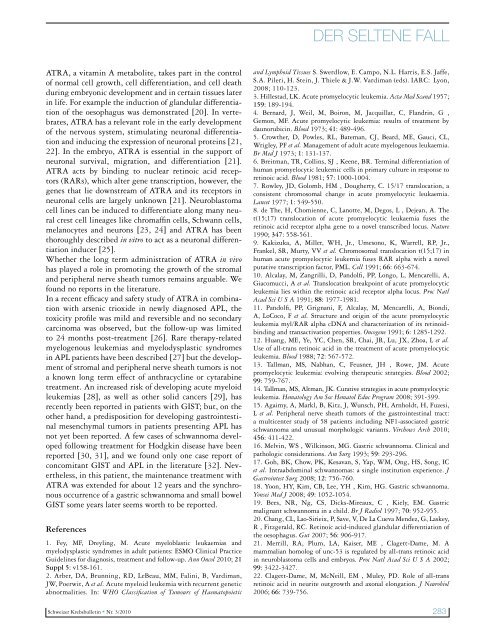Pragmatische Lösung eines komplexen Problems Schweizer ...
Pragmatische Lösung eines komplexen Problems Schweizer ...
Pragmatische Lösung eines komplexen Problems Schweizer ...
Sie wollen auch ein ePaper? Erhöhen Sie die Reichweite Ihrer Titel.
YUMPU macht aus Druck-PDFs automatisch weboptimierte ePaper, die Google liebt.
Der seltene Fall<br />
ATRA, a vitamin A metabolite, takes part in the control<br />
of normal cell growth, cell differentiation, and cell death<br />
during embryonic development and in certain tissues later<br />
in life. For example the induction of glandular differentiation<br />
of the oesophagus was demonstrated [20]. In vertebrates,<br />
ATRA has a relevant role in the early development<br />
of the nervous system, stimulating neuronal differentiation<br />
and inducing the expression of neuronal proteins [21,<br />
22]. In the embryo, ATRA is essential in the support of<br />
neuronal survival, migration, and differentiation [21].<br />
ATRA acts by binding to nuclear retinoic acid receptors<br />
(RARs), which alter gene transcription, however, the<br />
genes that lie downstream of ATRA and its receptors in<br />
neuronal cells are largely unknown [21]. Neuroblastoma<br />
cell lines can be induced to differentiate along many neural<br />
crest cell lineages like chromaffin cells, Schwann cells,<br />
melanocytes and neurons [23, 24] and ATRA has been<br />
thoroughly described in vitro to act as a neuronal differentiation<br />
inducer [25].<br />
Whether the long term administration of ATRA in vivo<br />
has played a role in promoting the growth of the stromal<br />
and peripheral nerve sheath tumors remains arguable. We<br />
found no reports in the literature.<br />
In a recent efficacy and safety study of ATRA in combination<br />
with arsenic trioxide in newly diagnosed APL, the<br />
toxicity profile was mild and reversible and no secondary<br />
carcinoma was observed, but the follow-up was limited<br />
to 24 months post-treatment [26]. Rare therapy-related<br />
myelogenous leukemias and myelodysplastic syndromes<br />
in APL patients have been described [27] but the development<br />
of stromal and peripheral nerve sheath tumors is not<br />
a known long term effect of anthracycline or cytarabine<br />
treatment. An increased risk of developing acute myeloid<br />
leukemias [28], as well as other solid cancers [29], has<br />
recently been reported in patients with GIST; but, on the<br />
other hand, a predisposition for developing gastrointestinal<br />
mesenchymal tumors in patients presenting APL has<br />
not yet been reported. A few cases of schwannoma developed<br />
following treatment for Hodgkin disease have been<br />
reported [30, 31], and we found only one case report of<br />
concomitant GIST and APL in the literature [32]. Nevertheless,<br />
in this patient, the maintenance treatment with<br />
ATRA was extended for about 12 years and the synchronous<br />
occurrence of a gastric schwannoma and small bowel<br />
GIST some years later seems worth to be reported.<br />
References<br />
1. Fey, MF, Dreyling, M. Acute myeloblastic leukaemias and<br />
myelodysplastic syndromes in adult patients: ESMO Clinical Practice<br />
Guidelines for diagnosis, treatment and follow-up. Ann Oncol 2010; 21<br />
Suppl 5: v158-161.<br />
2. Arber, DA, Brunning, RD, LeBeau, MM, Falini, B, Vardiman,<br />
JW, Poerwit, A et al. Acute myeloid leukemia with recurrent genetic<br />
abnormalities. In: WHO Classification of Tumours of Haematopoietic<br />
and Lymphoid Tissues S. Swerdlow, E. Campo, N.L. Harris, E.S. Jaffe,<br />
S.A. Pileri, H. Stein, J. Thiele & J.W. Vardiman (eds). IARC: Lyon,<br />
2008; 110-123.<br />
3. Hillestad, LK. Acute promyelocytic leukemia. Acta Med Scand 1957;<br />
159: 189-194.<br />
4. Bernard, J, Weil, M, Boiron, M, Jacquillat, C, Flandrin, G ,<br />
Gemon, MF. Acute promyelocytic leukemia: results of treatment by<br />
daunorubicin. Blood 1973; 41: 489-496.<br />
5. Crowther, D, Powles, RL, Bateman, CJ, Beard, ME, Gauci, CL,<br />
Wrigley, PF et al. Management of adult acute myelogenous leukaemia.<br />
Br Med J 1973; 1: 131-137.<br />
6. Breitman, TR, Collins, SJ , Keene, BR. Terminal differentiation of<br />
human promyelocytic leukemic cells in primary culture in response to<br />
retinoic acid. Blood 1981; 57: 1000-1004.<br />
7. Rowley, JD, Golomb, HM , Dougherty, C. 15/17 translocation, a<br />
consistent chromosomal change in acute promyelocytic leukaemia.<br />
Lancet 1977; 1: 549-550.<br />
8. de The, H, Chomienne, C, Lanotte, M, Degos, L , Dejean, A. The<br />
t(15;17) translocation of acute promyelocytic leukaemia fuses the<br />
retinoic acid receptor alpha gene to a novel transcribed locus. Nature<br />
1990; 347: 558-561.<br />
9. Kakizuka, A, Miller, WH, Jr., Umesono, K, Warrell, RP, Jr.,<br />
Frankel, SR, Murty, VV et al. Chromosomal translocation t(15;17) in<br />
human acute promyelocytic leukemia fuses RAR alpha with a novel<br />
putative transcription factor, PML. Cell 1991; 66: 663-674.<br />
10. Alcalay, M, Zangrilli, D, Pandolfi, PP, Longo, L, Mencarelli, A,<br />
Giacomucci, A et al. Translocation breakpoint of acute promyelocytic<br />
leukemia lies within the retinoic acid receptor alpha locus. Proc Natl<br />
Acad Sci U S A 1991; 88: 1977-1981.<br />
11. Pandolfi, PP, Grignani, F, Alcalay, M, Mencarelli, A, Biondi,<br />
A, LoCoco, F et al. Structure and origin of the acute promyelocytic<br />
leukemia myl/RAR alpha cDNA and characterization of its retinoidbinding<br />
and transactivation properties. Oncogene 1991; 6: 1285-1292.<br />
12. Huang, ME, Ye, YC, Chen, SR, Chai, JR, Lu, JX, Zhoa, L et al.<br />
Use of all-trans retinoic acid in the treatment of acute promyelocytic<br />
leukemia. Blood 1988; 72: 567-572.<br />
13. Tallman, MS, Nabhan, C, Feusner, JH , Rowe, JM. Acute<br />
promyelocytic leukemia: evolving therapeutic strategies. Blood 2002;<br />
99: 759-767.<br />
14. Tallman, MS, Altman, JK. Curative strategies in acute promyelocytic<br />
leukemia. Hematology Am Soc Hematol Educ Program 2008; 391-399.<br />
15. Agaimy, A, Markl, B, Kitz, J, Wunsch, PH, Arnholdt, H, Fuzesi,<br />
L et al. Peripheral nerve sheath tumors of the gastrointestinal tract:<br />
a multicenter study of 58 patients including NF1-associated gastric<br />
schwannoma and unusual morphologic variants. Virchows Arch 2010;<br />
456: 411-422.<br />
16. Melvin, WS , Wilkinson, MG. Gastric schwannoma. Clinical and<br />
pathologic considerations. Am Surg 1993; 59: 293-296.<br />
17. Goh, BK, Chow, PK, Kesavan, S, Yap, WM, Ong, HS, Song, IC<br />
et al. Intraabdominal schwannomas: a single institution experience. J<br />
Gastrointest Surg 2008; 12: 756-760.<br />
18. Yoon, HY, Kim, CB, Lee, YH , Kim, HG. Gastric schwannoma.<br />
Yonsei Med J 2008; 49: 1052-1054.<br />
19. Bees, NR, Ng, CS, Dicks-Mireaux, C , Kiely, EM. Gastric<br />
malignant schwannoma in a child. Br J Radiol 1997; 70: 952-955.<br />
20. Chang, CL, Lao-Sirieix, P, Save, V, De La Cueva Mendez, G, Laskey,<br />
R , Fitzgerald, RC. Retinoic acid-induced glandular differentiation of<br />
the oesophagus. Gut 2007; 56: 906-917.<br />
21. Merrill, RA, Plum, LA, Kaiser, ME , Clagett-Dame, M. A<br />
mammalian homolog of unc-53 is regulated by all-trans retinoic acid<br />
in neuroblastoma cells and embryos. Proc Natl Acad Sci U S A 2002;<br />
99: 3422-3427.<br />
22. Clagett-Dame, M, McNeill, EM , Muley, PD. Role of all-trans<br />
retinoic acid in neurite outgrowth and axonal elongation. J Neurobiol<br />
2006; 66: 739-756.<br />
<strong>Schweizer</strong> Krebsbulletin • Nr. 3/2010 283



